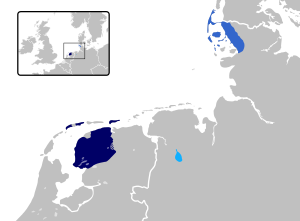Frisian language: Difference between revisions
Jump to navigation
Jump to search

George Swan (talk | contribs) (add image) |
mNo edit summary |
||
| Line 89: | Line 89: | ||
}} | }} | ||
</ref> | </ref> | ||
}} | }}[[Category:Suggestion Bot Tag]] | ||
Latest revision as of 06:01, 19 August 2024
Frisian is a West Germanic language spoken in the Dutch province of Friesland (Fris. Fryslân) and in a few small areas in northern Germany.[1] It is commonly divided into three dialect areas:
- West Frisian (the dialect spoken in the Netherlands);
- East Frisian (spoken in two neighboring municipalities in Saterland in the German Land of Lower Saxony; also known as Sater Frisian);
- North Frisian (spoken on the northwestern coast of the German Land of Schleswig-Holstein near the Danish border, and on the islands off the coast).
The language is closely related to English and Dutch. Through long contact with Dutch, the West-Frisian dialects have adopted many elements from Dutch in syntax and vocabulary. East Frisian and North Frisian are endangered as the number of speakers has dwindled rapidly in the twentieth century.
References
- ↑ [http://wjheeringa.nl/papers/tdg03.pdf "The Position of Frisian in the Germanic Language Area Charlotte Gooskens and Wilbert Heeringa"]. Retrieved on 2022-08-19. “Traditionally, they are divided into three subgroups: East Germanic (Gothic, which is no longer a living language), North Germanic (Icelandic, Faeroese, Norwegian, Danish, and Swedish), and West Germanic (English, German, Dutch, Afrikaans, Yiddish, and Frisian).”
